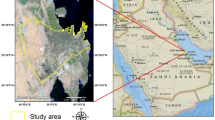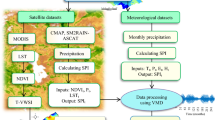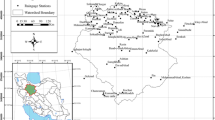Abstract
Droughts are particularly disastrous in South Africa and other arid regions that are water-scarce by nature due to low rainfall and water sources. According to some studies, droughts are not uncommon in Africa's drylands and have been rising in dry African terrain. Warm to hot summers and cool to cold winters describe the climate of the Free State Province, South Africa, a province that has been severely affected by drought events in recent times. Several studies have been carried out as regards drought prediction and mapping in arid and semi-arid areas using various models, tools and techniques. However, the use of machine learning algorithms is just emerging, especially in Sub-Saharan Africa. Studies have shown that machine learning and artificial intelligence methods have a high potential for assessment, prediction and identification of extreme events such as drought. Hence, this study aimed to evaluate drought dynamics in the Free State Province and identify drought drivers using regression-based algorithms. Results revealed that 2015 was severely affected by drought episodes as the study area observed extreme drought. More so, findings from this study showed that agricultural lands, cultivated grasslands, and barren surfaces were influenced or impacted by the drought disaster, especially in 2015, a drought year in the Free State Province. From the feature selection results, the influence of climate proxies and anthropogenic factors on VCI shows the ecological situation within the Free State Province.











Similar content being viewed by others
References
Abbas S, Nichol JE, Qamer FM, Xu J (2014) Characterization of drought development through remote sensing: a case study in Central Yunnan. China Remote Sens 6(6):4998–5018
Abubakar HB, Newete SW, Scholes MC (2020) Drought characterization and trend detection using the reconnaissance drought index for setsoto municipality of the free state province of South Africa and the impact on maize yield. Water 12(11):2993
Adedeji O, Olusola A, James G, Shaba HA, Orimoloye IR, Singh SK, Adelabu S (2020) Early warning systems development for agricultural drought assessment in Nigeria. Environ Monit Assess 192(12):1–21
Akinyemi FO (2017) Climate change and variability in semiarid palapye, eastern botswana: an assessment from smallholder farmers’ perspective. Weather, Climate, Soc 9(3):349–365
Akinyemi FO (2021) Vegetation trends, drought severity and land use-land cover change during the growing season in semi-arid contexts. Remote Sens 13(5):836
Albano CM, McGwire KC, Hausner MB, McEvoy DJ, Morton CG, Huntington JL (2020) Drought sensitivity and trends of riparian vegetation vigor in Nevada, USA (1985–2018). Remote Sensing 12(9):1362
AppEEARS Team (2020) Application for Extracting and Exploring Analysis Ready Samples (AppEEARS). Ver. 2.44. NASA EOSDIS Land Processes Distributed Active Archive Center (LP DAAC), USGS/Earth Resources Observation and Science (EROS) Center, Sioux Falls, South Dakota, USA. https://lpdaacsvc.cr.usgs.gov/appeears
Arastoo, B. (2013). The drought effects on land cover and land use evaluating by GIS and RS image processing in Northern Part Of Iran.
Awad M, & Khanna R. (2015). Support vector regression. In Efficient learning machines (pp. 67–80). Apress, Berkeley, CA.
Azadi H, Keramati P, Taheri F, Rafiaani P, Teklemariam D, Gebrehiwot K, Witlox F (2018) Agricultural land conversion: reviewing drought impacts and coping strategies. Int J Disaster Risk Reduct 31:184–195
Baudoin MA, Vogel C, Nortje K, Naik M (2017) Living with drought in South Africa: lessons learnt from the recent El Niño drought period. Int J Disaster Risk Reduct 23:128–137
Bechtel B, Demuzere M, & Stewart I. D. (2020). A weighted accuracy measure for land cover mapping: comment on Johnson et al. local climate zone (LCZ) map accuracy assessments should account for land cover physical characteristics that affect the local thermal environment. Remote Sens. 2019, 11, 2420. Remote Sensing, 12(11), 1769.
Beg, A. A. F., & Al-Sulttani, A. H. (2020). Spatial assessment of drought conditions over Iraq using the standardized precipitation index (SPI) and GIS techniques. In Environmental remote sensing and GIS in Iraq (pp. 447–462). Springer, Cham.
Belayneh, A., & Adamowski, J. (2013). Drought forecasting using new machine learning methods. J Water Land Dev.
Boguszewska-Mańkowska D, Pieczyński M, Wyrzykowska A, Kalaji HM, Sieczko L, Szweykowska-Kulińska Z, Zagdańska B (2018) Divergent strategies displayed by potato (Solanum tuberosum L.) cultivars to cope with soil drought. J Agron Crop Sci 204(1):13–30
Botai CM, Botai JO, Dlamini LC, Zwane NS, Phaduli E (2016) Characteristics of droughts in South Africa: a case study of free state and North West Provinces. Water 8(10):439
Breiman L (2001) Random forests. Mach Learn 45(1):5–32
Brown I, Poggio L, Gimona A, Castellazzi M (2011) Climate change, drought risk and land capability for agriculture: implications for land use in Scotland. Reg Environ Change 11(3):503–518
Burke EJ (2011) Understanding the sensitivity of different drought metrics to the drivers of drought under increased atmospheric CO2. J Hydrometeorol 12(6):1378–1394
Byakatonda J, Parida BP, Kenabatho PK, Moalafhi DB (2019) Prediction of onset and cessation of austral summer rainfall and dry spell frequency analysis in semiarid Botswana. Theoret Appl Climatol 135(1):101–117
Carter MR, Little PD, Mogues T, Negatu W (2006) Shocks, sensitivity and resilience: Tracking the economic impacts of environmental disaster on assets in Ethiopia and Honduras (No:580–2016-39326)
Cartwright JM, Littlefield CE, Michalak JL, Lawler JJ, Dobrowski SZ (2020) Topographic, soil, and climate drivers of drought sensitivity in forests and shrublands of the Pacific Northwest, USA. Sci Rep 10(1):1–13
Chai T, Draxler RR (2014) Root mean square error (RMSE) or mean absolute error (MAE)?–Arguments against avoiding RMSE in the literature. Geosci Model Dev 7(3):1247–1250
Conradie SR, Woodborne SM, Cunningham SJ, McKechnie AE (2019) Chronic, sublethal effects of high temperatures will cause severe declines in southern African arid-zone birds during the 21st century. Proc Natl Acad Sci 116(28):14065–14070
Cooperative Governance and Traditional Affairs (2016) Drought situation in Free State: water affairs briefing; State of South African Cities 2016: South African Cities Network briefing (https://pmg.org.za/committee-meeting/23605/)
Dai M, Huang S, Huang Q, Leng G, Guo Y, Wang L, Zheng X (2020) Assessing agricultural drought risk and its dynamic evolution characteristics. Agric Water Manag 231:106003
Downing, T. E., & Bakker, K. (2000). Drought risk in a changing environment. In Drought and drought mitigation in europe (pp. 79–90). Springer, Dordrecht.
Engelbrecht F, Adegoke J, Bopape MJ, Naidoo M, Garland R, Thatcher M, Gatebe C (2015) Projections of rapidly rising surface temperatures over Africa under low mitigation. Environ Res Lett 10(8):085004
Felsche E, Ludwig R (2021) Applying machine learning for drought prediction in a perfect model framework using data from a large ensemble of climate simulations. Nat Hazard 21(12):3679–3691
Feng P, Wang B, Li Liu D, Yu Q (2019) Machine learning-based integration of remotely-sensed drought factors can improve the estimation of agricultural drought in South-Eastern Australia. Agric Syst 173:303–316
Friedman J. H. (1991). Multivariate adaptive regression splines. The Annals of Statistics, 1–67.
Geladi P, Kowalski BR (1986) Partial least-squares regression: a tutorial. Anal Chim Acta 185:1–17
Ghasemi P, Karbasi M, Nouri AZ, Tabrizi MS, Azamathulla HM (2021) Application of Gaussian process regression to forecast multi-step ahead SPEI drought index. Alex Eng J 60(6):5375–5392
Greenwell BM (2017) pdp: an R package for constructing partial dependence plots. R J 9(1):421
Greenwell BM, Boehmke BC, Gray B (2020) Variable importance plots-an introduction to the vip package. R J 12(1):343
Grömping U (2009) Variable importance assessment in regression: linear regression versus random forest. Am Stat 63(4):308–319
Haile GG, Tang Q, Sun S, Huang Z, Zhang X, Liu X (2019) Droughts in East Africa: causes, impacts and resilience. Earth Sci Rev 193:146–161
Hassan Z, Shabbir R, Ahmad SS, Malik AH, Aziz N, Butt A, Erum S (2016) Dynamics of land use and land cover change (LULCC) using geospatial techniques: a case study of Islamabad Pakistan. Springerplus 5(1):1–11
He X, Estes L, Konar M, Tian D, Anghileri D, Baylis K, Sheffield J (2019) Integrated approaches to understanding and reducing drought impact on food security across scales. Curr Opin Environ Sustain 40:43–54
Hermans K, McLeman R (2021) Climate change, drought, land degradation and migration: exploring the linkages. Curr Opin Environ Sustain 50:236–244
Jamali A (2019) Evaluation and comparison of eight machine learning models in land use/land cover mapping using Landsat 8 OLI: a case study of the northern region of Iran. SN Appl Sci 1(11):1–11
Jin J, Wang Q, Li L (2016) Long-term oscillation of drought conditions in the western China: an analysis of PDSI on a decadal scale. J Arid Land 8(6):819–831
Jolliffe IT (1982) A note on the use of principal components in regression. J Roy Stat Soc: Ser C (appl Stat) 31(3):300–303
Kisi O, Parmar KS (2016) Application of least square support vector machine and multivariate adaptive regression spline models in long term prediction of river water pollution. J Hydrol 534:104–112
Kogan FN (1995) Droughts of the late 1980s in the United States as derived from NOAA polar-orbiting satellite data. Bull Am Meteorol Soc 76(5):655–668
Kogo BK, Kumar L, Koech R (2021) Climate change and variability in Kenya: a review of impacts on agriculture and food security. Environ Dev Sustain 23(1):23–43
Krange O, Kaltenborn BP, Hultman M (2019) Cool dudes in Norway: climate change denial among conservative Norwegian men. Environ Sociol 5(1):1–11
Kuhn M (2008) Building Predictive Models in R Using the caret Package. J Stat Softw 28(5):1–26. https://doi.org/10.18637/jss.v028.i05
Li K, Tong Z, Liu X, Zhang J, Tong S (2020) Quantitative assessment and driving force analysis of vegetation drought risk to climate change: methodology and application in Northeast China. Agric for Meteorol 282:107865
Li J, Wang Z, Wu X, Xu CY, Guo S, Chen X, Zhang Z (2021) Robust meteorological drought prediction using antecedent SST fluctuations and machine learning. Water Resources Research 57(8):e2020WR029413
Liu X, Zhu X, Zhang Q, Yang T, Pan Y, Sun P (2020) A remote sensing and artificial neural network-based integrated agricultural drought index: index development and applications. CATENA 186:104394
Luedeling E, Guo L, Dai J, Leslie C, Blanke MM (2013) Differential responses of trees to temperature variation during the chilling and forcing phases. Agric Meteorol 181:33–42
Lunyolo LD, Khalifa M, Ribbe L (2021) Assessing the interaction of land cover/land use dynamics, climate extremes and food systems in Uganda. Sci Total Environ 753:142549
Madasa A, Orimoloye IR, Ololade OO (2021) Application of geospatial indices for mapping land cover/use change detection in a mining area. J African Earth Sci 175:104108
Mahlstein I, Daniel JS, Solomon S (2013) Pace of shifts in climate regions increases with global temperature. Nat Clim Change 3(8):739–743
Mare F, Bahta YT, Van Niekerk W (2018) The impact of drought on commercial livestock farmers in South Africa. Dev Pract 28(7):884–898
Marengo JA, Cunha APM, Nobre CA, Neto GGR, Magalhaes AR, Torres RR, Álvala RC (2020) Assessing drought in the drylands of northeast Brazil under regional warming exceeding 4 C. Nat Hazards 103(2):2589–2611
McGovern A, Elmore KL, Gagne DJ, Haupt SE, Karstens CD, Lagerquist R, Williams JK (2017) Using artificial intelligence to improve real-time decision-making for high-impact weather. Bull Am Meteor Soc 98(10):2073–2090
Mera GA (2018) Drought and its impacts in Ethiopia. Weather Clim Extremes 22:24–35
Moeletsi ME, Walker S (2012) Assessment of agricultural drought using a simple water balance model in the free State Province of South Africa. Theoret Appl Climatol 108(3):425–450
Musolino DA, Massarutto A, de Carli A (2018) Does drought always cause economic losses in agriculture? An empirical investigation on the distributive effects of drought events in some areas of Southern Europe. Sci Total Environ 633:1560–1570
Muthelo D, Owusu-Sekyere E, Ogundeji AA (2019) Smallholder farmers’ adaptation to drought: identifying effective adaptive strategies and measures. Water 11(10):2069
Nabil M, Zhang M, Bofana J, Wu B, Stein A, Dong T, Shang J (2020) Assessing factors impacting the spatial discrepancy of remote sensing based cropland products: a case study in Africa. Int J Appl Earth Observation Geoinf 85:102010
Orimoloye IR, Ololade OO, Mazinyo SP, Kalumba AM, Ekundayo OY, Busayo ET, Nel W (2019) Spatial assessment of drought severity in Cape Town area, South Africa. Heliyon 5(7):e02148
Orimoloye IR, Ololade OO, Belle JA (2021a) Satellite-based application in drought disaster assessment using terra MOD13Q1 data across free state province, South Africa. J Environ Manag 285:112112
Orimoloye IR, Belle JA, Ololade OO (2021b) Drought disaster monitoring using MODIS derived index for drought years: a space-based information for ecosystems and environmental conservation. J Environ Manag 284:112028
Orimoloye IR, Olusola AO, Ololade O, Adelabu S (2021c) A persistent fact: reflections on drought severity evaluation over Nigerian sahel using MOD13Q1. Arab J Geosci. https://doi.org/10.1007/s12517-021-08369-5
Osaka S, Painter J, Walton P, Halperin A (2020) Media representation of extreme event attribution: a case study of the 2011–17 California drought. Weather, Climate, Soc 12(4):847–862
Otto FE, Wolski P, Lehner F, Tebaldi C, Van Oldenborgh GJ, Hogesteeger S, New M (2018) Anthropogenic influence on the drivers of the Western Cape drought 2015–2017. Environ Res Lett 13(12):124010
Pande CB, Moharir KN, Khadri SFR et al (2018) Study of land use classification in an arid region using multispectral satellite images. Appl Water Sci 8:123
Pande CB, Moharir KN, Khadri SFR (2021) Assessment of land-use and land-cover changes in Pangari watershed area (MS), India, based on the remote sensing and GIS techniques. Appl Water Sci 11:96
Panu US, Sharma TC (2002) Challenges in drought research: some perspectives and future directions. Hydrol Sci J 47(S1):S19–S30
Prasetyo S. Y. J, Hartomo K. D, Paseleng M. C, Candra D. W, & Simanjuntak B. H. (2019, July). The machine learning to detect drought risk in central java using landsat 8 OLI remote sensing images. In 2019 5th International conference on science and technology (ICST) (Vol. 1, pp. 1–6). IEEE.
Quan Q, Hao Z, Xifeng H, & Jingchun L. (2020). Research on water temperature prediction based on improved support vector regression. Neural Comput Appl, 1–10.
R Core Team (2019) R: a language and environment for statistical computing. R Foundation for Statistical Computing, Vienna, Austria. Available at: https://www.R-project.org/.
Raev I, & Rosnev B (2018). The impact of drought on natural forest ecosystems. In Drought in bulgaria (pp. 117–136). Routledge.
Rhee J, Im J (2017) Meteorological drought forecasting for ungauged areas based on machine learning: using long-range climate forecast and remote sensing data. Agric for Meteorol 237:105–122
Ribeiro AF, Russo A, Gouveia CM, Páscoa P (2019) Modelling drought-related yield losses in Iberia using remote sensing and multiscalar indices. Theoret Appl Climatol 136(1–2):203–220
Riebsame WE, Changnon SA, Karl TR (2019) Drought and natural resources management in the United States: Impacts and Implications of the 1987–89 Drought. Routledge
Rustad SA, Rosvold EL, Buhaug H (2020) Development aid, drought, and coping capacity. J Develop Stud 56(8):1578–1593
Shiau JT, Lin JW (2016) Clustering quantile regression-based drought trends in Taiwan. Water Resour Manage 30(3):1053–1069
Slette IJ, Post AK, Awad M, Even T, Punzalan A, Williams S, Knapp AK (2019) How ecologists define drought, and why we should do better. Glob Change Biol 25(10):3193–3200
Smola AJ, Schölkopf B (2004) A tutorial on support vector regression. Stat Comput 14(3):199–222
Sousa PM, Blamey RC, Reason CJ, Ramos AM, Trigo RM (2018) The ‘day zero’cape town drought and the poleward migration of moisture corridors. Environ Res Lett 13(12):124025
Sprain L (2017) Paradoxes of public participation in climate change governance. Good Soc 25(1):62–80
Steyn M, Meissner R, Nortje K, Funke N, & Petersen C (2019). Water security and South Africa. In Understanding water security at local government level in South Africa (pp. 1–44). Palgrave Pivot, Cham.
Sun F, Mejia A, Zeng P, Che Y (2019) Projecting meteorological, hydrological and agricultural droughts for the Yangtze River basin. Sci Total Environ 696:134076
Sweet SK, Wolfe DW, DeGaetano A, Benner R (2017) Anatomy of the 2016 drought in the Northeastern United States: implications for agriculture and water resources in humid climates. Agric for Meteorol 247:571–581
Swemmer AM, Bond WJ, Donaldson J, Hempson GP, Malherbe J, Smit IP (2018) The ecology of drought-a workshop report. S Afr J Sci 114(9–10):1–3
Tobias, R. D. (1995, April). An introduction to partial least squares regression. In Proceedings of the twentieth annual SAS users group international conference (Vol. 20). Cary: SAS Institute Inc.
Trnka M, Semerádová D, Novotný I, Dumbrovský M, Drbal K, ek Pavlík F, & Hlavinka P, (2016). Assessing the combined hazards of drought, soil erosion and local flooding on agricultural land: a Czech case study. Clim Res, 70(2-3), 231-249
van Wilgen NJ, Goodall V, Holness S, Chown SL, McGeoch MA (2016) Rising temperatures and changing rainfall patterns in South Africa’s national parks. Int J Climatol 36(2):706–721
Vicente-Serrano SM (2007) Evaluating the impact of drought using remote sensing in a mediterranean, semi-arid region. Nat Hazards 40(1):173–208
Wang Q, Yuan Z, Du Q, Li X (2018a) GETNET: A general end-to-end 2-D CNN framework for hyperspectral image change detection. IEEE Trans Geosci Remote Sens 57(1):3–13
Wang Y, Meng B, Zhong S, Wang D, Ma J, Sun W (2018b) Aboveground biomass and root/shoot ratio regulated drought susceptibility of ecosystem carbon exchange in a meadow steppe. Plant Soil 432(1):259–272
Wild M. (2012) Solar radiation versus climate change. In: Meyers R.A. (ed.) Encyclopedia of sustainability science and technology. Springer, New York, NY. https://doi.org/10.1007/978-1-4419-0851-3_448
Williams A, de Vries FT (2020) Plant root exudation under drought: implications for ecosystem functioning. New Phytol 225(5):1899–1905
Workman CL, Ureksoy H (2017) Water insecurity in a syndemic context: understanding the psycho-emotional stress of water insecurity in Lesotho, Africa. Soc Sci Med 179:52–60
Yu M, Cho Y, Kim TW, Chae HS (2018) Analysis of drought propagation using hydrometeorological data: from meteorological drought to agricultural drought. J Korea Water Resour as 51(3):195–205
Zhu Q, Luo Y, Zhou D, Xu YP, Wang G, Tian Y (2021) Drought prediction using in situ and remote sensing products with SVM over the Xiang River Basin. China Natural Hazards 105(2):2161–2185
Author information
Authors and Affiliations
Corresponding author
Ethics declarations
Ethical Approval
No ethical-related issues are associated with this study.
Additional information
Publisher's Note
Springer Nature remains neutral with regard to jurisdictional claims in published maps and institutional affiliations.
Rights and permissions
About this article
Cite this article
Orimoloye, I.R., Olusola, A.O., Belle, J.A. et al. Drought disaster monitoring and land use dynamics: identification of drought drivers using regression-based algorithms. Nat Hazards 112, 1085–1106 (2022). https://doi.org/10.1007/s11069-022-05219-9
Received:
Accepted:
Published:
Issue Date:
DOI: https://doi.org/10.1007/s11069-022-05219-9




